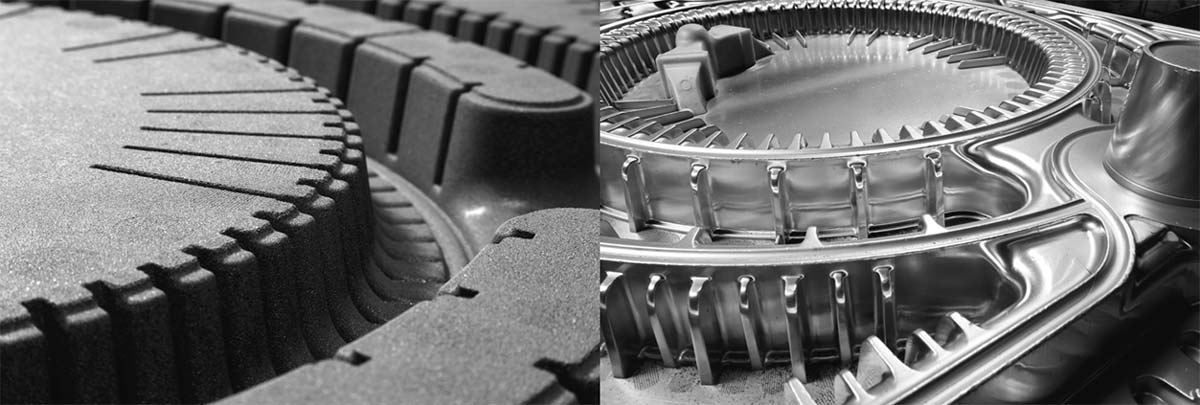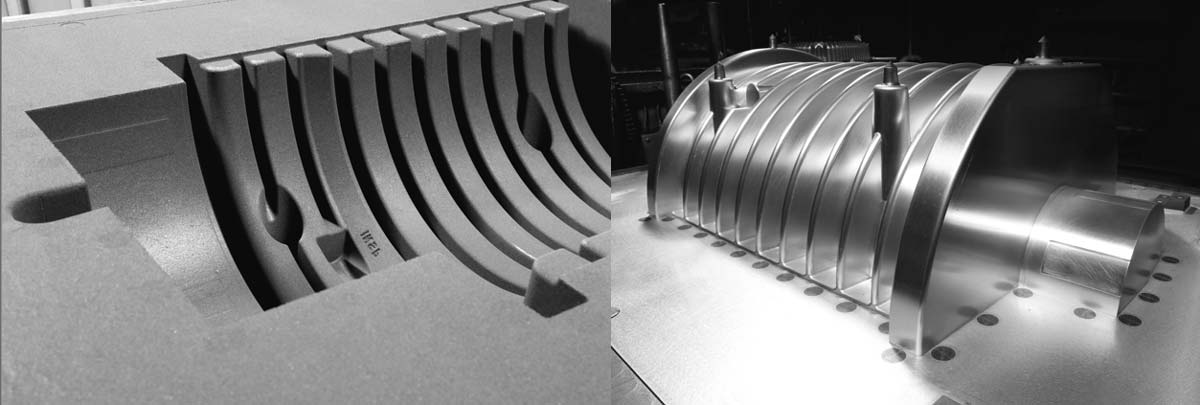

SEIATSU – The quiet airflow pre-compaction method for producing perfects moulds
The precise moulding of complex geometries is the challenge when manufacturing modern cast products. With the SEIATSU process, targeted pre-compaction of the mould material is possible through the precise steering of the airflow. This ensures optimum shaping accuracy, precision and strength of the green sand mould.
The process
Compaction of the mould sand takes place with the SEIATSU airflow squeeze moulding process. When the shutters on the sand metering device are opened, the required quantity of sand is poured into the mould cavity, which is formed by the model plate/model plate carrier, moulding flask and filling frame. After this, the sand metering device drives beneath the take-off belt of the sand storage hopper and the press crown over the mould cavity. The machine table lifts and presses the model plate carrier with moulding flask and filling frame against the press crown such that the entire mould chamber is hermetically sealed. The airflow valve is then briefly opened. An airflow penetrates the mould sand from the mould rear in the direction of the model and dissipates through nozzles in the model plate carrier or the model plate. The mould gains its ultimate strength through squeezing from above with a level pressure plate, elastic pressure plate or multi-stamp press. The sand metering device is refilled during the compaction process. Lowering the machine table separates the mould and model. At the same time, the sand metering device and press crown return to their initial positions.
The principle
The airflow
When air flows through the mould sand towards the model, the airflow creates a downward force exacted on every grain of sand. The sand flows with the airflow into the deeper model regions. Its packed density increases in the flow direction, layer by layer, so that the greatest compaction is achieved in the area close to the model. The squeezing results in an uniform mould.
The advantages
Fewer cores
Cores can be omitted in many areas because the even mould hardness with the SEIATSU process facilitates the moulding of complex model contours and extreme faces.
Consistent mould hardness
This is the prerequisite throughout the entire mould for producing precisely dimensioned cast pieces. A comparison between alternative processes and SEIATSU shows the significantly more efficient hardening progression with a SEIATSU mould.
Reduction in mould draft angles
The reduced mould draft angles with the SEIATSU process, to just 0.5° and less, reduces the material used and also results in lower processing costs.
Improved use of the mould surface
Due to the smaller distances between the models and from the moulding flask wall, denser model plate allocation is possible. This means: more cast pieces per mould.
Reduction in cleaning costs
High quality cast parts of consistent quality – with outstanding surfaces produced with dimensional accuracy and almost entirely free of burrs with the SEIATSU process – result in significantly lower cleaning and rework costs.
Leading-edge technology
The SEIATSU process takes place free of vibrations. This means: lower foundation costs, less disruptions and lower maintenance costs.
